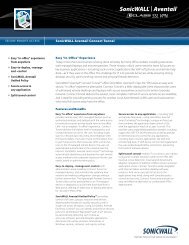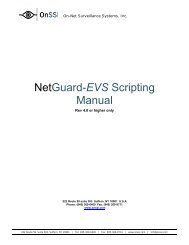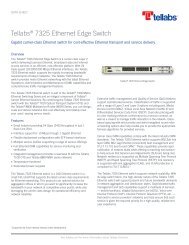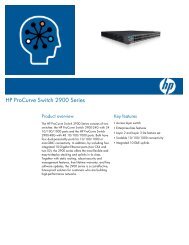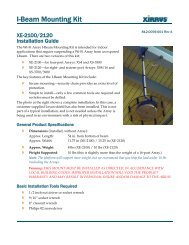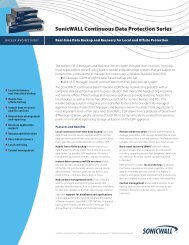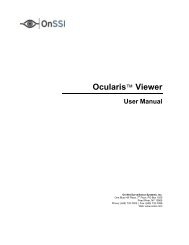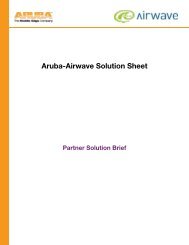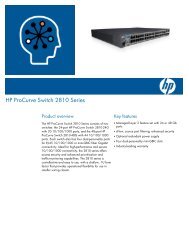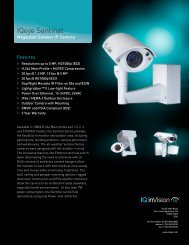Ocularis DS - Specifications Sheet - Moonblink
Ocularis DS - Specifications Sheet - Moonblink
Ocularis DS - Specifications Sheet - Moonblink
Create successful ePaper yourself
Turn your PDF publications into a flip-book with our unique Google optimized e-Paper software.
<strong>Ocularis</strong> <strong>DS</strong> 1.0 <strong>Specifications</strong><br />
<strong>Ocularis</strong> <strong>DS</strong> - <strong>Specifications</strong> <strong>Sheet</strong><br />
Version 1.0, November 2009<br />
For full list of features, see in <strong>Ocularis</strong> <strong>DS</strong> Architecture & Engineering (A&E) document, available by request only.<br />
General<br />
<strong>Ocularis</strong> <strong>DS</strong> is a comprehensive video-centric Physical Security Information Management (PSIM) platform which<br />
provides management and coordination of integrated physical security, content analytic, radiation and other sensor<br />
detection, transaction and other enterprise systems, as well as full VMS functionality, centralized event, end-user<br />
system-wide rights and video recording and distribution management.<br />
The <strong>Ocularis</strong> <strong>DS</strong> VMS component enables the user to view, manage, and record video from an unlimited number of<br />
IP and non-IP video surveillance cameras at multiple sites, manage short- and long-term video storage, and combine<br />
video with non-video alerts, resulting in automatic video delivery to subscribers of interest.<br />
Major System Components<br />
<strong>Ocularis</strong> <strong>DS</strong> is a unified, modular software platform that consists of a number of components:<br />
1. <strong>Ocularis</strong> <strong>DS</strong> Base: Provides system-wide management, user access, shared event management, alarm and<br />
event correlation, video access, and distribution rights.<br />
2. <strong>Ocularis</strong> Recorder - NetDVMS: Video recording, storage management, video delivery to users and camera<br />
management.<br />
3. <strong>Ocularis</strong> Client: Access to video, management of alerts and shared event handling is done through the unified<br />
Video Client software, for desktop and control room video wall environments.<br />
4. Add-Ons and Integrated Applications: Video Wall management; Video Content Analytics; forensics<br />
applications; and integrated physical security solutions (access control, radiation detection, contact closure, etc.)<br />
System Highlights<br />
• Video-Centric Physical Security Information Management (PSIM): <strong>Ocularis</strong> <strong>DS</strong> manages video and event<br />
data from multiple DVR, NVR and VMS systems as well as physical security, content analytic, environmental<br />
detection, transaction and other enterprise systems.<br />
• Designed for Integration: <strong>Ocularis</strong> <strong>DS</strong> allows the integration of a host of add-on components via integration tools<br />
including Generic ASCII Generated Events, API commands, Contact Closure and more. An optional Software<br />
Development Kit (SDK) enables integration of 3 rd -party components.<br />
• Scalable, Multi-Site Multi-Server: <strong>Ocularis</strong> <strong>DS</strong> supports unlimited cameras and integrated devices and systems,<br />
connected to multiple recording servers at multiple sites. Video from any camera (including two-way audio) can be<br />
accessed by authorized users from anywhere in the network, through multiple video clients for desktop, video wall<br />
and mobile (handheld) operation.<br />
• Open-Architecture, Non-Proprietary Technology: <strong>Ocularis</strong> <strong>DS</strong> runs on off-the-shelf PC hardware; and supports<br />
all leading manufacturers’ cameras and devices (over 500 models) as well as all industry-standard compression<br />
formats (MPEG4, MJPEG, H.263 and H.264).<br />
• Central Management for Alerting, Shared Event Handling, Client Asset and User Authorization Data: All<br />
recording servers and <strong>Ocularis</strong> Client users are managed by the <strong>Ocularis</strong> <strong>DS</strong> Base, which coordinates all event<br />
and alert handling, manages users’ rights to specific cameras and functions system wide (Active Directory<br />
supported), and distributes all shared assets.<br />
• Per-Camera Configuration of All Video Streaming, Recording and Archiving Parameters: The <strong>Ocularis</strong><br />
Recorder - NetDVMS for <strong>Ocularis</strong> <strong>DS</strong> enables optimizing system resources through per-camera configuration for<br />
compression level/format, image resolution, bandwidth, framerate, conditional recording, retention time, archiving<br />
frequency, archiving location and more.<br />
Confidential to On-Net Surveillance Systems Inc.<br />
www.onssi.com<br />
Page 1 of 7
<strong>Ocularis</strong> <strong>DS</strong> 1.0 <strong>Specifications</strong><br />
• Highly Intuitive Uniform Video Client: <strong>Ocularis</strong> Client offers a user-friendly operator interface, for both desktop<br />
and control room video-wall environments, with only minutes of training required for full proficiency.<br />
• Live Monitoring with Instantaneous Investigation: While monitoring live video feeds, users can perform basic<br />
investigation on individual cameras – playback, digital PTZ and optical PTZ (for PTZ cameras) - without the need<br />
to switch to a dedicated investigation mode.<br />
• Multiple Investigation Tools: <strong>Ocularis</strong> Client’s investigation tools, include the Kinetic Motion Timeline, multiparameter<br />
motion detection, the Time Slicer and the Motion Slicer, as well as the optional VideoSynopsis and<br />
Video Content Analytics add-ons.<br />
• Shared Event Handling: Recorded events are handled simultaneously by multiple operators, bookmarked and<br />
exported as evidence in multiple formats, all within minutes.<br />
Detailed Features and Functionality<br />
<strong>Ocularis</strong> <strong>DS</strong> Base<br />
The VC-PSIM Base<br />
components.<br />
Application manages the flow of event, user and system status data from the various system<br />
• Event Management: All events within the <strong>Ocularis</strong> <strong>DS</strong> platform, as well as messages received from external<br />
devices and systems, are managed through the <strong>Ocularis</strong> <strong>DS</strong> Base administrator. These include camera<br />
connected I/O messages; motion detection events; camera status events and others.<br />
• Composite Events (‘Event Fusion’): Composite Events are created by linking two camera events or alerts,<br />
configured by sequence order, time interval and logical conditioning (e.g. ‘If Door A opens, but no motion<br />
detection on Camera N, within 15 seconds’). Composite Events can be fused with other events to create complex<br />
detection scenarios, and assigned priority for push video and handling by <strong>Ocularis</strong> Client operators.<br />
• Automatic Push Video Alerting (Blank Screen Monitoring): Upon event, a push-video alert of the camera that<br />
triggered the alert, or any other camera, can be sent to users running the <strong>Ocularis</strong> Client application. In addition,<br />
the alert can be configured to trigger alarms or send notifications to users.<br />
• Management of Users, User Groups and Authorizations: Users are assigned to Active Directory-supported<br />
authorization groups, granting users rights for accessing cameras, operating specific camera and video wall<br />
functions (including PTZ controls and presets, accessing recorded video and initiating recording for specific<br />
cameras).<br />
• Schedule-Basefor overriding holidays, are configured through a simple Distribution of Events to Users: Multiple activity ranges for each day of the week, as well as<br />
GUI.<br />
• Camera Array Views for Video Client User: By logging in to the <strong>Ocularis</strong> <strong>DS</strong> Base, users gain access to<br />
Views – arrays of different dimension and pane size combination, containing camera streams, hotspots, carousels,<br />
web pages and images, and push-video panes. View panes can be configured for image resolution, framerate,<br />
carousel dwell time, etc.<br />
• Repository for Shared Assets System-Wide: Shared asset management, for video wall maps and icons and<br />
events tagging/classification tables.<br />
O cularis Recorder - NetDVMS<br />
• Scalable Architecture: unlimited number of cameras, connected to multiple recording servers (up to 64 cameras<br />
per server) at multiple sites; support for MJPEG, MPEG4, H.263 and H.264 compression formats, at image<br />
resolutions up to 5MP and framerates of 30 fps; support for analog cameras via a wide range of IP video<br />
encoders.<br />
• Administrator Application: feature-rich administration interface for each recording server, for setup and<br />
configuration of cameras and I/O devices, camera event settings, archive settings, scheduling, and soft buttons<br />
for manually triggered events.<br />
• Recording and Archiving: per-camera configuration for compression format (for multiple format cameras);<br />
image resolution; frame rate; image parameters (brightness, contrast), archiving retention time, and archiving<br />
location.<br />
Confidential to On-Net Surveillance Systems Inc.<br />
www.onssi.com<br />
Page 2 of 7
<strong>Ocularis</strong> <strong>DS</strong> 1.0 <strong>Specifications</strong><br />
• Maintenance-Free, Transparent Archiving: Multiple archiving instances per day on local or remote (network)<br />
drives. The archive for each camera is stored in a separate database. No down-time during transfer for video to<br />
archive.<br />
• Recording Viewer: Dedicated application for viewing exporting multi-camera video databases.<br />
• Optimized bandwidth and hardware utilization: Optional monitoring and recording at two different frame rates<br />
and image resolution settings.<br />
• Recording Settings: Individual cameras can be configured for recording on motion, continuous recording, or<br />
either based by schedule; and for pre- and post-recording (buffer) on motion/event. Optional speed-up recording<br />
on event.<br />
• PTZ Preset Settings: 50 presets per PTZ camera, controllable from each camera’s view pane in <strong>Ocularis</strong> Client.<br />
• Audio: Two way audio (from camera/IP device-connected microphones and to camera/IP device-connected PA<br />
system); audio from cameras is recorded and included in export of evidence (as AVI file).<br />
• Networking: Support for Multi-Network operation; Port Forwarding (for access from outside a NAT firewall); and<br />
SNMP (for camera status and camera event alerting).<br />
• Network Topology: Support for segmented (VLAN or dedicated network) or shared networks, for physical<br />
network separation between the camera and the recording servers and video clients.<br />
• Outside Network Access: the NetDVMS administrator is able to allow/prevent access from outside the local IP<br />
address range. The configuration settings allows selecting an Outside IP Address, Outside IP Port, Local IP<br />
Ranges, Maximum Number of Clients.<br />
• User Authentication: Via MS Active Directory user accounts and groups/Windows accounts; user administration<br />
via <strong>Ocularis</strong> <strong>DS</strong> Base.<br />
• Logging: Detailed logging, including Overall System log, Event log and Audit log<br />
• Virtualization: Support for VMware and MS Virtual PC®<br />
• Background Operation: NetDVMS runs as a Windows® service, with no need for user login. Service can be<br />
stopped/started, and provides system status and logging information.<br />
<strong>Ocularis</strong> Client, <strong>Ocularis</strong> Viewer and Mobile (Handheld) Clients<br />
<strong>Ocularis</strong> Client<br />
• Unified Client for <strong>Ocularis</strong>: <strong>Ocularis</strong> Client is the main video client for all OnSSI <strong>Ocularis</strong> solutions.<br />
• Unlimited Concurrent Users: No limit on the number of concurrent client users, and no incremental cost for<br />
additional <strong>Ocularis</strong> Clients.<br />
• User Authentication: Basic or Windows Active Directory-supported<br />
• Touchscreen-Enabled, Intuitive Interface: <strong>Ocularis</strong> Client’s intuitive, touchscreen-enabled GUI reacts to the<br />
user’s actions, presenting only the controls and tools required by the current mode of operation.<br />
• Multiple Screen Support: for dual-screen and quad-screen monitoring workstations.<br />
• Mixed Content Views: Users can select among unlimited private or administrator-configured pane arrays of<br />
different sizes (up to 8x8 panes), consisted of camera streams, carousels, hotspots, web browser/static<br />
image/flash animation (requires file support on client machine), and panes for receiving automatic (on-event) and<br />
manual (peer-to-peer) push-video alerts.<br />
• Pane View/Full Screen Toggle: Any view pane can be toggled between pane and full-screen viewing modes.<br />
• Live Monitoring Assisted by Instantaneous Investigation: A-synchronous live monitoring, with per-camera<br />
controls for playback, pause/live, digital PTZ, optical PTZ and PTZ presets (for PTZ cameras) and dedicated<br />
parsing controls for cameras equipped with 360-degree (Panamorphic) lens.<br />
• Digital PTZ: Applicable in all viewing modes, and assisted by PIP (Picture-in-Picture) for easy orientation. Control<br />
methods include draw rectangle, mouse wheel zoom in/out, and dragging selected PTZ region in PIP window.<br />
Confidential to On-Net Surveillance Systems Inc.<br />
www.onssi.com<br />
Page 3 of 7
<strong>Ocularis</strong> <strong>DS</strong> 1.0 <strong>Specifications</strong><br />
• Unified Optical PTZ Control: All PTZ cameras are manipulated using the same controls, regardless of<br />
make/model. Controls include: mouse wheel (zoom in/out), variable zoom ribbon, zoom in/out buttons, point-to-<br />
Center, click-draw rectangle, PTZ preset list (unlimited presets) virtual joystick and physical joystick.<br />
• PTZ Prioritization: Users, within user groups, are assigned priority levels for controlling PTZ cameras.<br />
• 360-Degree Lens Controls: Special controls are provided for parsing views from fixed cameras equipped with<br />
360-degree (Panamorphic) lens. The parsed view emulates a PTZ camera, with simulated pan, tilt and zoom.<br />
360-degree parsing is available for both wall or ceiling mounted cameras, in single or quad view within a single<br />
camera pane, with playback and digital zoom controls.<br />
• Smart Carousel Monitoring: Carousel panes, displaying cameras in a predefined sequence, include controls for<br />
pause/restart rotation, next and previous camera.<br />
• Change Cameras on the Fly: In all viewing modes, the current camera can be instantly replaced by selecting<br />
another camera from a drop-down list.<br />
• Manual Push-Video Alerting: users are able to send a live push-video alert to other <strong>Ocularis</strong> Client users<br />
(selectable from a drop-down list). Pushed video alerts can be investigated using playback, digital PTZ and<br />
Optical PTZ controls.<br />
• Copy Current Camera View to Clipboard: users are able to copy live or recorded camera views, for pasting in<br />
other documents or editing using image editing software.<br />
• Switch Audio Streams: Audio streams from camera-connected microphones can be switched on and off,<br />
selectable from a menu list.<br />
• Activate Outputs: I/O devices can be activated directly from <strong>Ocularis</strong> Client, including visual and audio alarms,<br />
contact closure, etc.<br />
• Investigation and Access to Events: Multiple tools are provided for quickly accessing and investigating video of<br />
incidents:<br />
o<br />
o<br />
o<br />
o<br />
o<br />
o<br />
Synchronous Camera View: Current live monitoring view will carry upon transitioning to Browse<br />
mode, with synchronous playback, skip to next/previous event and skip to next/previous event<br />
sequence.<br />
Go to Time/Date: Through ‘odometer’-style control<br />
Kinetic Motion Timeline: scalable horizontal timeline, with kinetic variability (responding to the<br />
momentum and speed of the user’s ‘swiping’ movement). Allows reviewing extended periods of<br />
recorded video in a short time, with color indicators for recorded video and detected motion.<br />
Highly Configurable Motion Detection: calibrated for percentage of changed pixels within the<br />
motion detection zone; sensitivity and detection sampling time interval.<br />
‘Time Slicer’ Tool Set: The Time Slicer tool set auto-generates thumbnails, for rapid drill-down to<br />
the moment of an event, based on time interval, motion detection, camera alerts and alert<br />
sequences. All Time Slicer tool enable the application of digital PTZ to all slices, by drawing a<br />
region in the Timeslicer main pane.<br />
Video Synopsis: Optional add-on module for <strong>Ocularis</strong> <strong>DS</strong>. Creates a minutes-long summary clip of<br />
all events that took place over hours of recorded video. The clip also serves as an event index,<br />
linking between movements in the clip to the original recording.<br />
• Shared Event Handling: All events generated within the <strong>Ocularis</strong> <strong>DS</strong> system, or detected by external/add-on<br />
devices, are entered in a dynamically-updated, shared among all authorized users. Users are able to access,<br />
investigate and handle events directly from a dedicated event handling interface, with an on-map indicator of the<br />
camera that triggered the event and dual video panes displaying the recorded event and a live stream. Handled<br />
events may be accessed by the administrator for continued handling.<br />
Confidential to On-Net Surveillance Systems Inc.<br />
www.onssi.com<br />
Page 4 of 7
<strong>Ocularis</strong> <strong>DS</strong> 1.0 <strong>Specifications</strong><br />
• Event Bookmarking and Export of Evidence:<br />
o<br />
o<br />
o<br />
Segments of video for bookmarking and exported are graphically selected on the Kinetic Motion<br />
Timeline.<br />
Bookmarks are tagged, classified and commented by users, and copied into a Bookmark database.<br />
Bookmarked events are presented along all event information and thumbnail of the incident.<br />
Video evidence is exported as annotated still image report; multiple still frames; audio-included AVI<br />
file with annotated preamble, and court-admissible, multi-camera video database package, which<br />
includes a dedicated player.<br />
• Map-based Navigation and Video Wall Management: cameras and camera arrays are accessible through a<br />
map-based interface, used also for Video Wall management (requires optional <strong>Ocularis</strong> VideoWall add-on).<br />
o<br />
o<br />
o<br />
o<br />
Multiple maps, with hyperlinked icons to other maps, cameras and camera groups. Map images are<br />
scalable and movable.<br />
On-map live preview windows of cameras and camera groups, with full playback, digital PTZ and<br />
optical PTZ (where available) controls.<br />
Cameras and camera groups are pushed to local displays or remote video wall (optional; requires<br />
<strong>Ocularis</strong> VideoWall add-on) displays by simple drag-and-drop. Cameras displayed on video walls<br />
are located on their respective maps via a Locator control.<br />
Views sent to remote video walls are controlled for playback, digital PTZ and optical PTZ, via a<br />
dedicated control panel.<br />
• Private View Configuration: users are able to configure private views, from within the client, combining camera<br />
streams, carousels, push video alerts (automatic and manual), hotspots and webpage/image panes.<br />
<strong>Ocularis</strong> VideoWall (optional)<br />
• Allows sending video to video wall monitors and remote displays anywhere on the network, all from the <strong>Ocularis</strong><br />
Client’s intuitive, map-based controller interface<br />
• Instantly push cameras and camera groups to any display on the network<br />
• Accommodates any number of cameras, displays and simultaneous operators at multiple sites.<br />
• Eliminates the need for analog multiplexing hardware<br />
• Ideal for command and control centers, central station and remote alarm monitoring operations.<br />
Handheld Clients<br />
• NetPDA and NetCell, for Windows (CE/Mobile) PDAs and Smartphones (both included for unlimited users with<br />
<strong>Ocularis</strong> <strong>DS</strong>) provide secure access to live and recorded video from any camera on the network, with playback,<br />
optical PTZ controls and PTZ preset selection.<br />
o<br />
o<br />
Features include horizontal and vertical operation; connected I/O device controls; instant access to<br />
video by time/date, alert sequence, frame-by-frame playback and variable playback speed.<br />
Additional handheld clients of <strong>Ocularis</strong> <strong>DS</strong> available from select 3 rd -party vendors.<br />
<strong>Ocularis</strong> <strong>DS</strong> Viewer<br />
• A dedicated viewer is included with <strong>Ocularis</strong> <strong>DS</strong> for playback of exported evidence as multiple-camera video<br />
database.<br />
Confidential to On-Net Surveillance Systems Inc.<br />
www.onssi.com<br />
Page 5 of 7
<strong>Ocularis</strong> <strong>DS</strong> 1.0 <strong>Specifications</strong><br />
<strong>Ocularis</strong> Analytics<br />
• Video Content Analytics: <strong>Ocularis</strong> Analytics, an optional add-on for <strong>Ocularis</strong> <strong>DS</strong>, provides automated detection<br />
of targeted movements and behaviors by people and vehicles. Analytics-generated alerts can be pushed<br />
automatically to users’ Video Clients, together with a graphical metadata overlay indicating the object or<br />
movement that triggered the event.<br />
o<br />
o<br />
o<br />
o<br />
Multiple detectors, for a variety of behaviors, can be applied to a single camera.<br />
Compatible with on-edge processing, providing the advantage of processing raw (pre-compression)<br />
video data.<br />
PTZ Analytics functionality, including PTZ tracking and motion detection on PTZ presets<br />
Detection, alerting and reporting modules for a variety of human & vehicular behaviors, including<br />
movement in zone, line crossing, crowding, tailgating, loitering, grouping, object counting,<br />
stickiness, moving water vessel, object left behind, stopped vehicle, road obstacle and asset<br />
protection.<br />
<strong>Ocularis</strong> VideoSynopsis (optional)<br />
• Optional Module for the <strong>Ocularis</strong> Platform<br />
• Powered by the BriefCam VideoSynopsis TM engine<br />
• Enables the compression of video activity into a very short time frame for faster identification of key events<br />
• A day of video footage can be compressed into a few minutes-long video clip, indexed for instant access to each<br />
detected incident or movement<br />
Hardware Requirements<br />
<strong>Ocularis</strong> <strong>DS</strong> Base Server:<br />
• CPU: Intel® Xeon®, minimum 2.0 GHz (Dual Core or better recommended)<br />
• RAM: Minimum 2 GB<br />
• Network: Ethernet (1 Gbit recommended)<br />
• Operating System: Microsoft® Windows® Server 2003/2008*<br />
• Software: Microsoft .NET 3.5 SP1 Framework; IIS 6.0 or newer<br />
<strong>Ocularis</strong> <strong>DS</strong> Admin<br />
• CPU: Intel® Core2 Duo CPU 2.8 GHz<br />
• RAM: Minimum 2 GB<br />
• Network: Ethernet (100 Mb or higher recommended)<br />
• Operating System: Microsoft® Windows® XP Professional SP2* or Vista*<br />
• Graphics Adapter: Adapter: PCI-Express, 128 MB RAM, Direct 3D supported<br />
<strong>Ocularis</strong> Recorder - NetDVMS Recording Server:<br />
• CPU – Intel® Xeon Processor (Intel Core 2 Duo recommended)<br />
• RAM – Minimum 2 GB<br />
• Network – Ethernet, 1 GB<br />
• Hard Disk Type – SATA, SCSI, SAS.<br />
• Hard Disk Space – Minimum 80 GB free (depends on number of cameras and recording settings).<br />
• Operating System – Microsoft® Windows® XP Professional* Microsoft® Windows® Vista Business/Enterprise/Ultimate*, Server<br />
2003*/2008*<br />
• Internet Information Services (IIS) 5.0 or later and Microsoft .NET Framework 1.1. required for running NetPDA Server<br />
<strong>Ocularis</strong> Client<br />
• CPU: Intel® Core 2 Quad CPU 2.8 GHz<br />
Confidential to On-Net Surveillance Systems Inc.<br />
www.onssi.com<br />
Page 6 of 7
<strong>Ocularis</strong> <strong>DS</strong> 1.0 <strong>Specifications</strong><br />
• RAM: Minimum 2 GB<br />
• Network: Ethernet (100 Mb or higher recommended)<br />
• Operating System: Microsoft® Windows® XP Professional SP2* or Vista 32bit*<br />
• Graphics Adapter: Adapter: PCI-Express, 256 MB RAM, Direct 3D supported<br />
Note: Recommended hardware specifications for an <strong>Ocularis</strong> Client workstation in a production environment vary depending upon<br />
the number of video streams, video resolution, and number of monitors. Refer to the <strong>Ocularis</strong> Client User Manual for more detail.<br />
Portable Clients (NetPDA/NetCell)<br />
• Operating System - Microsoft® Windows® Pocket PC 2003/2003, SE/Mobile 5.0.<br />
• CPU - Inte®l StrongARM or 100% compatible.<br />
• RAM - Minimum 32 MB.<br />
• Network - Ethernet (256 Kbit or higher recommended)<br />
• Graphics Adapter - Minimum 320 x 200, 16 bit colors.<br />
VideoSynopsis Server (Required one per 8 Synopsis-equipped camera channels.)<br />
• CPU: Intel® Xeon® Quad Core<br />
• RAM: 2GB<br />
• Hard Disk: 500GB<br />
• Operating System: Microsoft® Windows® XP Professional, Vista, Server 2003/2008<br />
• The server requires an activated HASP plug plugged into its USB port.<br />
<strong>Ocularis</strong> Analytics Server<br />
No. of Devices 1-50 50-100 100-400<br />
CPU 2.8GHz, Core 2 2GHz, Quad Core Dual 2GHz, Quad Core<br />
RAM 2GB 4GB 6-8GB<br />
Hard Disk<br />
40GB<br />
Network<br />
1 Gbit<br />
OS<br />
XP Pro SP2*;<br />
2003 Server Standard<br />
Vista*<br />
Database SQL 2005 Express SQL 2005 Standard or Express<br />
Graphics Adapter 64MB RAM; 128MB if running the Analytic Configuration Client<br />
*32 bit or 64 bit running as 32 bit<br />
Copyright (C) 2009, On-Net Surveillance Systems, Inc. OnSSI and the 'Eye' logo are registered trademarks of On-Net Surveillance<br />
Systems, Inc. <strong>Ocularis</strong>, NetEVS, NetDVMS, NetDVR, ProSight, NetGuard, <strong>Ocularis</strong> VideoWall, NetMatrix, NetCentral, NetTransact,<br />
NetPDA and NetCell are trademarks of On-Net Surveillance Systems, Inc. All other trademarks are property of their respective<br />
owners. OnSSI reserves the right to change product specifications without prior notice.<br />
Confidential to On-Net Surveillance Systems Inc.<br />
www.onssi.com<br />
Page 7 of 7



